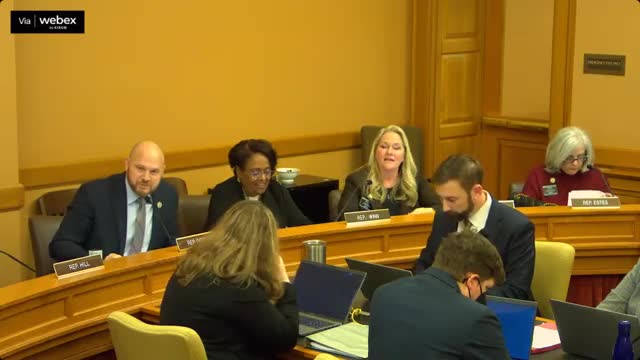Kansas representatives describe district needs to education budget committee: special‑education shortfalls, staffing, ESL and mental‑health pressures
January 16, 2025 | Committee on K-12 Education Budget, Standing, HOUSE OF REPRESENTATIVES, Committees, Legislative, Kansas
This article was created by AI summarizing key points discussed. AI makes mistakes, so for full details and context, please refer to the video of the full meeting. Please report any errors so we can fix them. Report an error »

Members of the Committee on K‑12 Education Budget heard short, district‑level reports from representatives across the state that highlighted several recurring local challenges: special‑education funding shortfalls, staffing and recruitment pressures, language diversity and English‑learner supports, student mental‑health needs, and capital needs in growing districts.
"We talk a lot about the state statute that requires 92% reimbursement of special education costs," said Representative Poskins while describing Blue Valley School District’s budget stress. He told the committee that Blue Valley faced a roughly $13,700,000 shortfall for the 2023–24 school year after state special‑education reimbursement did not cover the district’s costs and the district transferred that amount from its general fund to meet required IEP services.
Representatives from both urban and rural districts described similar themes. Representative McDonald said Olathe — the Kansas City metro district she described as the second largest in the state — faces increasing numbers of non‑English‑speaking students, more students eligible for free and reduced lunches, and a growing and more severe special‑education caseload that drives costs and staffing strain. She said Olathe’s graduation rate is 91.3% and reported a student population of approximately 28,500.
Smaller and rural districts raised other pressures: Representative Smoy said Ottawa has roughly 2,200 students with about 60% eligible for free and reduced lunch and that the district is a major local employer. Representative Bowesley and others described strong technical and career pathways in their regions but noted declining enrollment in some rural areas.
Several members cited staff recruitment and retention as a major problem tied to rising cost of living and commuting distances. Representative McDonald described situations where staff cannot afford to live in‑district and must commute, and several members reported districts resorting to short‑term bonds or reappropriations to cover technology and other needs.
Language diversity and newcomer students drew repeated attention: Representative Wynne said Kansas City, Kansas, has more than 70 languages spoken and about 19,000 students with roughly 85% qualifying for free and reduced lunch; she described intensive language programs and dual‑enrollment partnerships in the district. Representative Hobson (Dodge City) described a high migrant population and transient enrollments that challenge continuity of instruction.
Union representation was noted in the hearing when Tim Grama of the Kansas National Education Association (KNEA) introduced himself as representing some 22,000 teachers and said KNEA will engage with the Legislature on salaries and bargaining.
Why it matters: committee members will use these district reports as context for budget deliberations and for requests to KSDE and other agencies for supplemental funding, special‑education reimbursements, mental‑health supports and staffing incentives.
The committee did not take formal votes on these matters during the hearing; members asked staff for more data and materials and will receive district‑level budget and performance reports in coming briefings.
"We talk a lot about the state statute that requires 92% reimbursement of special education costs," said Representative Poskins while describing Blue Valley School District’s budget stress. He told the committee that Blue Valley faced a roughly $13,700,000 shortfall for the 2023–24 school year after state special‑education reimbursement did not cover the district’s costs and the district transferred that amount from its general fund to meet required IEP services.
Representatives from both urban and rural districts described similar themes. Representative McDonald said Olathe — the Kansas City metro district she described as the second largest in the state — faces increasing numbers of non‑English‑speaking students, more students eligible for free and reduced lunches, and a growing and more severe special‑education caseload that drives costs and staffing strain. She said Olathe’s graduation rate is 91.3% and reported a student population of approximately 28,500.
Smaller and rural districts raised other pressures: Representative Smoy said Ottawa has roughly 2,200 students with about 60% eligible for free and reduced lunch and that the district is a major local employer. Representative Bowesley and others described strong technical and career pathways in their regions but noted declining enrollment in some rural areas.
Several members cited staff recruitment and retention as a major problem tied to rising cost of living and commuting distances. Representative McDonald described situations where staff cannot afford to live in‑district and must commute, and several members reported districts resorting to short‑term bonds or reappropriations to cover technology and other needs.
Language diversity and newcomer students drew repeated attention: Representative Wynne said Kansas City, Kansas, has more than 70 languages spoken and about 19,000 students with roughly 85% qualifying for free and reduced lunch; she described intensive language programs and dual‑enrollment partnerships in the district. Representative Hobson (Dodge City) described a high migrant population and transient enrollments that challenge continuity of instruction.
Union representation was noted in the hearing when Tim Grama of the Kansas National Education Association (KNEA) introduced himself as representing some 22,000 teachers and said KNEA will engage with the Legislature on salaries and bargaining.
Why it matters: committee members will use these district reports as context for budget deliberations and for requests to KSDE and other agencies for supplemental funding, special‑education reimbursements, mental‑health supports and staffing incentives.
The committee did not take formal votes on these matters during the hearing; members asked staff for more data and materials and will receive district‑level budget and performance reports in coming briefings.
View full meeting
This article is based on a recent meeting—watch the full video and explore the complete transcript for deeper insights into the discussion.
View full meeting
